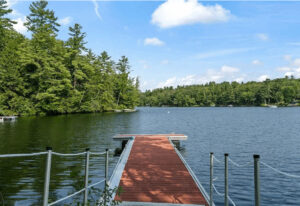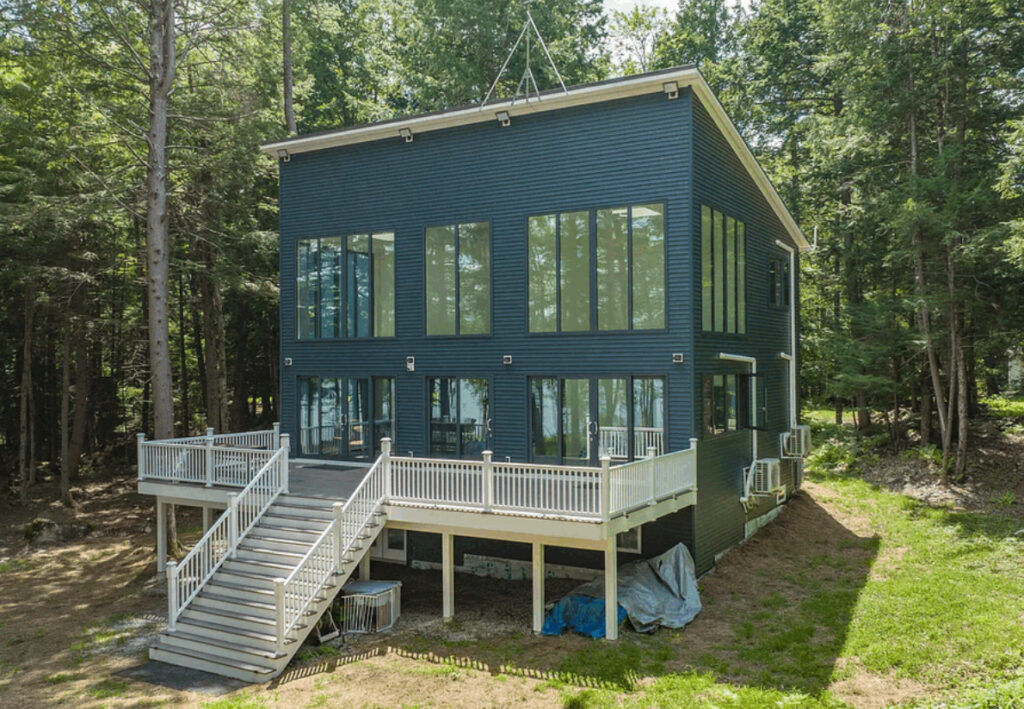

In Harrison, Maine, on the slender spine of Zakelo Island—one of the most secluded spits of land stretching into the clean waters of Long Lake—there now sits a box. Not a house with a boxy style. Not a cabin with clean lines. A box. Big, unapologetic, and unblinking. It is one of only six homes permitted on this tiny island, and it doesn’t so much sit in the landscape as it defies it. A brutalist monument to modern convenience, standing in hard-edged contrast to the softened grace of Maine’s natural splendor.
This home, with its 3 beds, 4 baths, and 25-foot ceilings, is a lesson in architectural confrontation. It asks questions without really wanting answers. It demands attention from every angle. And it leaves anyone with a sense of reverence for nature wondering what we’re trying to prove when we build like this—especially here.
Nature As A Backdrop, Not A Partner
Long Lake, in this quiet corner of Maine, is all about restraint. It’s not flashy. It doesn’t need to be. The appeal has always been its simplicity: the slow rhythm of boats humming across glassy waters, the hush of pines leaning over the shoreline, the flicker of loons skimming the surface at dusk. Zakelo Island is a rare privilege—barely a dot on a map and home to a scarce handful of properties that, historically, have known how to keep their heads down and their roofs low.
Then came the cube.
Not content to tuck itself into the woods or follow the lines of the land, this home goes tall. Twenty-five-foot ceilings are an architectural flex, but when your neighbors are birch trees and osprey nests, it reads less like ambition and more like intrusion. It’s not just the height. The home’s right angles cut against the grain of the forest like a blade. Steel and glass stretch from base to sky in open defiance of the island’s gentle contours. It looks like someone airlifted a structure from downtown Boston and dropped it onto the moss.
There’s nothing wrong with modern design. Flat roofs, exposed materials, even the stark clarity of minimalist aesthetics have their place. But context matters. And when you’re one of six homes on an island in one of the most pristine environments in the northeast, how you choose to take up space isn’t just a personal decision. It’s a statement—one made in concrete, chrome, and glass.
The Amenity Arms Race
What’s the logic behind a structure like this? Inside, the house boasts more than just height. There’s a high-end kitchen, full smart-home integration, walls of windows, and sleek materials from top to bottom. Everything is built to impress, to pamper, to perform. It’s a design that screams “resort” more than “retreat.”
Even the dock access—something you’d expect to be humble or rustic on an island like Zakelo—is engineered for maximum visual and functional impact. The waterline is no longer just a place to launch a canoe; it’s a staging ground for aquatic status.
This is the state of upper-tier real estate now: amenity escalation. The assumption that buyers not only want luxury, but want a certain kind of luxury. Not comfort. Not coziness. Spectacle.
But is that what the island needs? Is it what we need?
Because while soaring ceilings and automation and panoramic glass might play well in a Palm Springs spread, here—among the balsams and granite—they can start to feel like a misfire. The cube on Zakelo is less about living with the land and more about asserting dominance over it.
When Architecture Stops Listening
Architecture should speak to its surroundings. That doesn’t mean every house needs to look like a log cabin. It does mean that materials, forms, and proportions should respond to the environment rather than override it. This isn’t just about aesthetics; it’s about respect. About restraint. About the ability to say: this place matters more than my ego.
The cube doesn’t listen. It doesn’t nod to tradition. It doesn’t care about the lake or the woods or the generations of families who’ve paddled these waters with a reverence that borders on spiritual. It’s a monologue in steel and sheetrock. And that might be its most glaring flaw—not its scale, or its shape, or its shine—but its tone-deafness.
There’s a reason most camps and cottages here keep things modest. Why screened porches and painted floorboards persist. It’s not nostalgia—it’s wisdom. People here understand that when you’re lucky enough to call this place home, your job is to disappear into it, not dominate it.
The Seduction of the Spectacle
Still, we get it. The cube is striking. It’s the kind of house that gets featured. That gets noticed. There’s an allure to that. And in a real estate market obsessed with novelty and Instagrammable design, being bold counts for something.
But at what cost?
The cube represents a larger shift in how we view the concept of “home” in nature. Where once escape meant simplicity, now it often means replication—bringing every square inch of urban opulence into the wild. In doing so, we risk losing the very thing we came to find: silence, balance, humility, awe.
Because once you’re inside a structure like this—with its radiant heating and polished concrete and automated shades—it’s hard to feel the lake anymore. Hard to hear the trees. The walls are thick, the windows sealed, the air calibrated. Nature becomes a view, not a presence.
The Future of Places Like Zakelo
This cube isn’t just a house. It’s a test case. A prototype for what might come next.
If more homes on islands like Zakelo follow this lead, we’ll see the slow erosion of what made these places special in the first place. Not by pollution or overuse, but by indifference. By the slow, relentless flattening of local character in favor of global sameness. The same glass walls in the Berkshires. The same lighting packages in the San Juans. The same minimalist furniture in the Adirondacks. Different places, same look. Same story.
Maine doesn’t need more spectacle. It needs protection. It needs caretakers. People who understand that living here is a privilege, not a right to remake the land in your own image.
Impression: A Plea For Remoteness
In the end, this cube will probably sell fast. It will be praised for its daring design, its engineering, its efficiency. But it will always be what it is: a transplant. A conversation-stopper. A sharp object in a soft world.
Let’s be clear: design can be bold and grounded. Homes can be luxurious without being invasive. And beauty doesn’t always need to shout to be seen.
The next time someone builds on Zakelo—or any island like it—let’s hope they ask not just “what can I build?” but “what belongs here?” Let them remember that some of the most breathtaking things in this world aren’t the ones that stand out, but the ones that fit in.
No comments yet.









